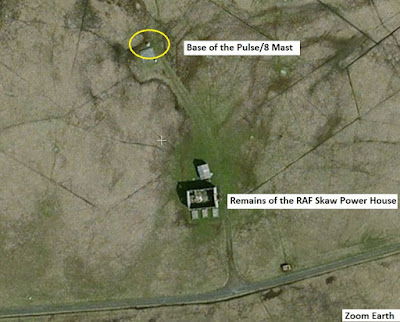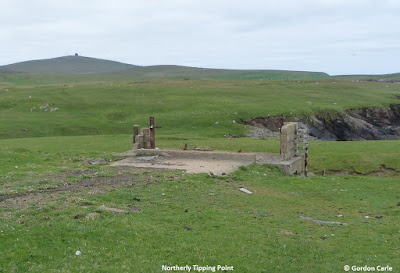RAF Skaw did not close immediately after VE Day (Monday 8
May 45), ships were still at sea, Coastal Command had ongoing operations and
there was the remote possibility that some German aircrew would not accept that
the war was over. VJ Day, 15 Aug 45, marked the end of the war in Far East. The
Skaw Chain Home Station actually ceased reporting on 4 Aug 45 and was placed on
care and maintenance with effect from the 22nd - two weeks later. However, some
classified experimental work kept some of the equipment operational and a few
dedicated personnel on site for a period after this. The operational history
notes that in Oct 45 "Both Channels of the Type 1 AMES at SKAW (the Chain
Home Radar) on a "caretaking basis" have been overhauled by a Wing
party: authority had not been received as yet from HQ 60 Group to lower the
Transmitter curtain arrays" Then there is an entry on 21 Nov, which says: "Type
1 Skaw: Gave instructions for this Station to become operational for the
limited purposes of research on Air Ministry instructions".
Early in the New Year ('46) there are further entries: "The
Type 1 at SKAW, although on a care and maintenance basis, has been carrying out
transmissions for experiments in Porto Rico. The R.N.A. (Radio Navigation Aid) channel
at SKAW has been placed on a caretaking basis, and it has been found impossible
to carry on with experimental transmissions. Authority has been sought from HQ
No. 60 Group to cease transmissions on the type 1" and, on 24 Feb 46 it is
recorded that; "The experimental work being carried out at SKAW was
discussed with M.3. It was pointed out
that this section was holding two mechanics at SKAW for this experimental work,
and it was requested that information be obtained as to the probable duration of
the experiment. M.3. pursued the matter with HG No. 60 Group, but since Air
Ministry and WASHINGTON are involved, no immediate decision could be given".
So far I have not been able to discover the nature of this "experimental
work" with US. It may well be unrelated but, the Loran navigation site,
AMES713 at Outer Skaw just north of RAF Skaw, closed down on 20 Feb 46 and was
placed on care & maintenance.
At one stage the number of servicemen based in Shetland
during WWII peaked at over 20,000. All of these men had to be fed, accommodated
and transported. As early as 1946, it
was realised that it would not be economic to ship much of the less valuable
material back to the UK mainland. In the next few years many items were sold
off within Shetland and the opportunity for those civilians with a little
capital to purchase items like nissen huts, wooden huts , barrack room
furniture and some vehicles, existed. Unst with Skaw, the Navy radar on Saxa
& the Home Guard would have had plenty of material for disposal. However,
at the time when the Transmitter and Receiver towers were demolished in 1947,
much of the Domestic Site was still standing. The following photo, taken from
the top of one of the 360' Transmitter
Towers, was sent to the late Lexie McMeechan by Leslie Smith:
The decision to dismantle the RAF Skaw Chain Home site
(along with a number of others), was not long in coming. The Towers were blown
up in 1947. The following photo from an Unst History Group Calendar shows the
northerly 360' Transmitter Tower in the process of collapsing, with the hill of
Saxa Vord in the left background:
Unfortunately this tower landed on the roof of the uninhabited
Transmitter Block, where it caused some damage, as can be seen in this picture
from Leslie Smith:
Some of the damage is still visible 70 years later:
The 240' wooden Receiver Towers came down more successfully,
but I have no idea what happened to the tons of Douglas Fir they had been
constructed with - but I could make a few guesses, wood being a scarce commodity
on Unst!
As can just be seen in the left of
picture above, the 105' Mk3 IFF mast is still standing but it was probably
lowered, using the cable guys, soon after.
After a short time the only structures left were those which
had been built with concrete and bricks (Bunkers, Power House, Cook House, Air
Raid Shelters, etc). During Aug 54 the land, which had been occupied by the Air
Ministry for RAF Skaw, it's Remote
Reserve and subsequent Loran site, was derequisitioned (ie, returned to its previous
owners).
Coincidentally, 1954 was when preparatory work on the
construction of RAF Saxa ,
with its Power House and Bulk Fuel Installation, began. Once again many workers from Shetland and the
UK Mainland were needed for the projects and it is quite possible that many of
the civilians who helped build the WWII sites in the Islands and some of the ex servicemen who
worked on them were involved.
In the period since RAF Skaw closed the land the military
occupied has seen many different activities.
Primarily the area has been returned to crofting use but many leisure
pursuits have also taken place. For a number of years the personnel from RAF
Saxa Vord had a self-maintained golf course, the Standby Power house has been
used by local boat owners to provide shelter for maintenance work and for a
while the galley for the Norwick Up Helly Aa was assembled in the building.
The headland at Inner Skaw has become a place for rock
climbers to practise their hobby on its cliffs and, with its extreme
north-easterly position, it makes an attractive landing point for rarer
migratory birds which can attract many "twitchers".
With the discovery of North Sea Oil two new masts were
erected for navigation/communication purposes. The first, and smaller of the
two, was erected just to the south of the old CH Receiver Blocki. It was owned
by Racal Survey Norway and operated as
part of a system called Deltafix, a photo from Mike Pennington is below:
Part 4 of RAF Skaw - Transmitters
& Receivers is here: http://ahistoryofrafsaxavord.blogspot.com/2018/06/a-history-of-raf-skaw-ames-no-56-part-4.html
Air 26 - 094 HQ 70 Wg ORB Appendices, The National Archive
AIR 26 - 095 HQ 70 Wg ORB, The National Archive
Air 26 - 100 HQ 71 Wg ORB, The National Archive
SD 0458 - Photographic Record of Radar Stations (Ground), Air Ministry, Aug
43
Mike Dean MBE
Leslie Smith
Gerry Firmin
Lexie McMeechan
Rita Carle
The second structure
was a 300' guyed mast from Racal Survey and was part of the Pulse/8
system:
Both the Delafix and Pulse/8 systems were similar to an
advanced form of Loran and, over shorter distances, enabled the crews of
vessels involved in the North Sea Oilfields to fix their positions with great
accuracy.
From the Mid 50's both the RAF and the Admiralty had
personnel at Saxa. Unfortunately people generate rubbish and, in the days
before the Council accepted responsibility for removing domestic waste from
service establishments, much of it was disposed of at the site of RAF Skaw
using 2 tipping points (use dependent upon wind direction and strength). It is
possible that these two places were in use during WWII but I have no record of
that. The first tipping point, to the south, was into an area called The
Mooasunds and looked like this:
The second site was very close and to the north of the headland, at a place called Gwykerls Geo:
The amount of debris which accumulated over the years, both
from civilians and servicemen, was considerable and included numerous vehicles
and much machinery!
Occasionally, when parts of RAF Saxa Vord were being
refurbished, there would be an interchange of information between service
employees and civilians. MOD would not allow used items to be given away, only
sold by strictly supervised auctions - difficult to organise in Unst - or physically
scrapped. It was not unknown at certain times for folk to be below the tipping
points to see what scrapped goodies
would descend on them from above! Early in the 90's I think the Shetland Islands
Council agreed to collect domestic waste from RAF Saxa Vord and, initially,
this was taken to official landfill sites - although some people continued
dumping at Skaw it could no longer be considered "legal" to do so. There was a less
well known third tipping site, possibly constructed for the Admiralty in the 50's,
at Outer Skaw. This was used to dump material into Forn Geo.
Another activity in the 70's, which would be strongly
discouraged nowadays, was the use of a structure built in 1940 as part of the
RAF Skaw Advance Chain Home radar site, for fire practice. This was illustrated
in the Saxa bog here: http://ahistoryofrafsaxavord.blogspot.co.uk/2012/10/fire-practice-at-inner-skaw-part-2.html
The area suffered a setback in 1995 when the road to Skaw (The
Floggie), had to be closed as unsafe. Large cracks had appeared and there was a
great danger of the cliff side collapsing into the water below:
Eventually a new, much longer, road was built and it was
possible to gain vehicular access to
Skaw by a route which avoided the cliffs altogether.
At the end of the 20th century an unsuccessful attempt was
made to get money from the "Millennium Fund" to turn the old RAF Skaw
Receiver Block into a safe visitor attraction, in the hope of generating
tourist activity. Those of you who
believe in the preservation of historic sites will be pleased to know that in
2012 Historic Environment Scotland designated RAF Skaw, both main and reserve
sites, a "scheduled monument" - the details of this decision may be
seen here: http://portal.historicenvironment.scot/designation/SM13097
Previous
articles on RAF Skaw
Part 1 of RAF Skaw - Inception to Jan '41 is here:
http://ahistoryofrafsaxavord.blogspot.co.uk/2018/04/a-history-of-raf-skaw-ames-no56-part-1.html
Part 2 of RAF Skaw - Advance CH - From Jan 41 to May 42s is here:
http://ahistoryofrafsaxavord.blogspot.co.uk/2018/05/a-history-of-raf-skaw-ames-56-part-2.html
Part 3 of RAF Skaw - CH Ops is here:
http://ahistoryofrafsaxavord.blogspot.com/2018/05/a-history-of-raf-skaw-ames-56-part-3-ch.html
Part 1 of RAF Skaw - Inception to Jan '41 is here:
http://ahistoryofrafsaxavord.blogspot.co.uk/2018/04/a-history-of-raf-skaw-ames-no56-part-1.html
Part 2 of RAF Skaw - Advance CH - From Jan 41 to May 42s is here:
http://ahistoryofrafsaxavord.blogspot.co.uk/2018/05/a-history-of-raf-skaw-ames-56-part-2.html
Part 3 of RAF Skaw - CH Ops is here:
http://ahistoryofrafsaxavord.blogspot.com/2018/05/a-history-of-raf-skaw-ames-56-part-3-ch.html
Part 5 of RAF Skaw - Some of
the Other Buildings at RAF Skaw
http://ahistoryofrafsaxavord.blogspot.com/2018/07/a-history-of-raf-skaw-ames-56-part-5.html
http://ahistoryofrafsaxavord.blogspot.com/2018/07/a-history-of-raf-skaw-ames-56-part-5.html
Part 6 of RAf Skaw - Defence &
Protection
Part 7 of A RAF Skaw - Remote Reserve AMES 56R
CONTENTS LIST



















No comments:
Post a Comment